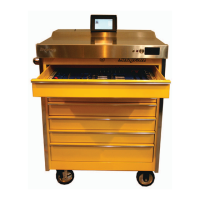5
Introduction Introduction
INTRODUCTION
Snap-on Automatic Tool Control boxes are designed as accountability systems for users of tools in environments where
safety is of utmost importance. ATC systems encourages tool responsibility while maintaining an organized inventory of
tools. Advantages of the ATC system include the ability to train the unit to accept various lighting environments. The unit
can adapt to tool wear and contaminants over time. Systems are setup to the unique requirements of each user work sta-
tion.
A box can be congured to audit box contents by one or two users required to verify the return of tools. This is a fail safe
buddy system to double check tool return. Both users will login when directed.
On delivery of the ATC system, the box needs to be trained for the environment. While the box already knows what the tool
inventory is it needs to become familiar with ambient lighting and shadows. The installation technician will perform this vital
procedure. The training can then be performed by the user/administrator whenever the lighting or environment changes to
enhance tool recognition.
Setup also requires the Box Administrator to be determined and assigned. Box users are then assigned as well and their
respective user control level (permissions).
ATC systems are connected to the Local area network or LAN, either wired or wireless, for monitoring of the box usage and
inventory and reporting features.
Box sizes and congurations and inventory will vary depending on job requirements.
After conguration a user can log-in and select tools for the job. He then logs out of the system. ATC systems log the tools
removed from the box by this user. Another user can login and remove tools. Any number of registered users can remove
and return tools regardless of the order they were removed. The ATC unit keeps a log of each tool user for accountability.
An ATC box uses video cameras to record tool activity. Drawer activity is recorded as a JPG image and retained for record
or audit by the administrator.

